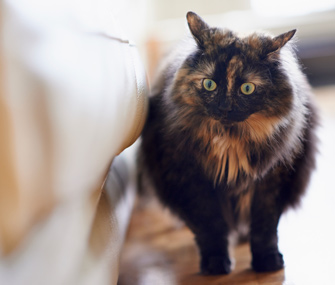Why Does My Pet… Pace at Night?
Published on September 12, 2016
Skip To

While dogs have often curled up alongside us, ready to sound any requisite alarm or snooze watchfully nearby, our cats have historically taken some of that time to hunt, catch and kill the small prey that like to steal our food. Hence, the symbiotic evolution of people and their pets.
When this nighttime routine gets interrupted by the constant clickety-clack of paws pacing up and down stairs or navigating the hallway repetitively at night, that delicate balance is easily upset.
Why Wear a Path in the Floor?
Why do some pets do this when others seem to settle so well into their expected routines? Here are a few possible causes for pacing behavior that apply to both cats and dogs:Cognitive dysfunction: Dogs and cats can both experience this syndrome, which is characterized by dementia-like behaviors. This occurs typically as a result of old-age changes to the brain and often leads to pacing behavior, particularly at night. The pacing may happen as a result of alterations in the sleep-wake cycle, anxiety related to mental confusion or other factors associated with the syndrome.
Other changes in mental activity: Any disease that leads to alterations in brain function can potentially induce seemingly disoriented behaviors — including pacing. These conditions may include seizure disorders, certain liver diseases, brain tumors, infections that affect the brain and toxin exposure.
Anxiety in general: Regardless of age, some pets pace when anxious. Sudden changes or severe stress in their environment, sometimes related to storms or loud noises (like fireworks), can lead to pacing behavior.
Pain: Pets who experience pain, especially sudden pain, may engage in pacing behavior. Acute back pain and bloat are examples of painful conditions that may cause a pet to pace or behave restlessly.
Compulsive behavior: Though considered rare, dogs and cats can engage in repetitive behaviors such as pacing that may be classified as “compulsive.”
Not Always At Night
With the exception of cognitive dysfunction, in which pacing tends to occurs most frequently at night, this traipsing back and forth is not necessarily only a nighttime activity. Nevertheless, owners tend to notice this behavior most often at night when they’re at home decompressing from the day or trying to sleep.If you’re concerned about your pet’s pacing behavior, see your veterinarian. Depending on what’s causing your pet’s pacing, there may be ways to help reduce her anxiety, confusion or pain through environmental and behavior modification, special diets, nutritional supplements or medications.
More on Vetstreet:
- Why Does My Dog Lick Me?
- Stinky Dog? 6 Possible Culprits
- 4 Odd Cat Sleeping Habits Explained
- 10 Most Overlooked Aches and Pains in Cats
- Why Doesn’t My Dog… Sleep in Bed With Me?





